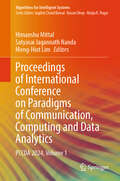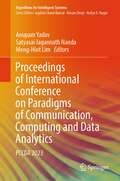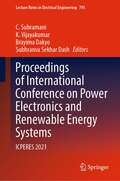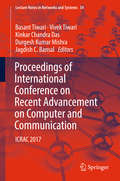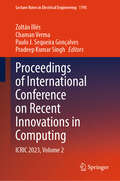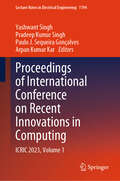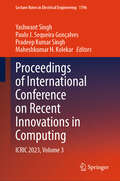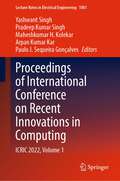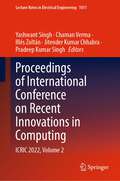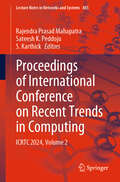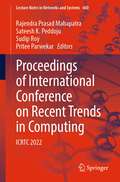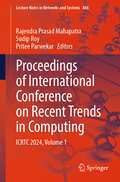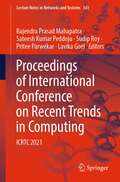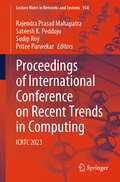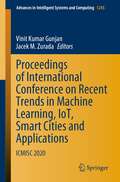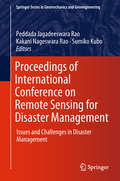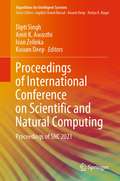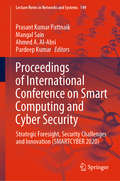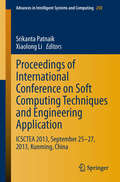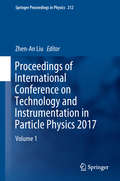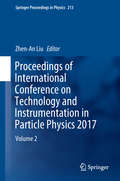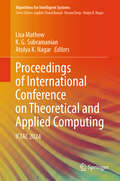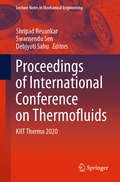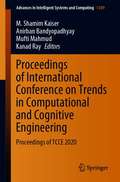- Table View
- List View
Proceedings of International Conference on Paradigms of Communication, Computing and Data Analytics: PCCDA 2024, Volume 1 (Algorithms for Intelligent Systems)
by Himanshu Mittal Satyasai Jagannath Nanda Meng-Hiot LimThis book is a collection of selected high-quality research papers presented at the International Conference on Paradigms of Communication, Computing and Data Analytics (PCCDA 2024), held at Pt. Lalit Mohan Sharma Campus, Rishikesh, Sri Dev Suman Uttarakhand University, Uttarakhand, India, during 20–21 April 2024. It discusses cutting-edge research in the areas of advanced computing, communications and data science techniques. The book is a collection of the latest research articles in computation algorithm, communication and data sciences, intertwined with each other for efficiency.
Proceedings of International Conference on Paradigms of Communication, Computing and Data Analytics: PCCDA 2023 (Algorithms for Intelligent Systems)
by Anupam Yadav Satyasai Jagannath Nanda Meng-Hiot LimThis book is a collection of selected high-quality research papers presented at International Conference on Paradigms of Communication, Computing and Data Analytics (PCCDA 2023), held at South Asian University, New Delhi, India, during 22–23 April 2023. It discusses cutting-edge research in the areas of advanced computing, communications and data science techniques. The book is a collection of latest research articles in computation algorithm, communication and data sciences, intertwined with each other for efficiency.
Proceedings of International Conference on Power Electronics and Renewable Energy Systems: ICPERES 2021 (Lecture Notes in Electrical Engineering #795)
by C. Subramani K. Vijayakumar Brayima Dakyo Subhransu Sekhar DashThis book features selected papers from the International Conference on Power Electronics and Renewable Energy Systems (ICPERES 2021), organized by SRM Institute of Science and Technology, Chennai, India, during April 2021. It covers recent advances in the field of soft computing applications in power systems, power system modeling and control, power system stability, power quality issues and solutions, smart grid, green and renewable energy technology optimization techniques in electrical systems, power electronics controllers for power systems, power converters and modeling, high voltage engineering, networking grid and cloud computing, computer architecture and embedded systems, fuzzy logic control, fuzzy decision support systems, and control systems. The book presents innovative work by leading academics, researchers, and experts from industry.
Proceedings of International Conference on Recent Advancement on Computer and Communication: Icrac 2017 (Lecture Notes In Networks And Systems #34)
by Basant Tiwari Vivek Tiwari Kinkar Chandra Das Durgesh Kumar Mishra Jagdish C. BansalThe book is a compilation of best papers presented at International Conference on Recent Advancement in Computer and Communication (ICRAC 2017) organized by IMPLab Research and Innovation Foundation, Bhopal, India. The book covers all aspects of computers and communication techniques including pervasive computing, distributed computing, cloud computing, sensor and adhoc network, image, text and speech processing, pattern recognition and pattern analysis, digital signal processing, digital electronics, telecommunication technologies, robotics, VLSI technologies, embedded system, satellite communication, digital signal processing, and digital communication. The papers included are original research works of experts from industry, government centers and academic institutions; experienced in engineering, design and research.
Proceedings of International Conference on Recent Innovations in Computing: ICRIC 2023, Volume 2 (Lecture Notes in Electrical Engineering #1195)
by Zoltán Illés Chaman Verma Paulo J. Sequeira Gonçalves Pradeep Kumar SinghThis book features selected papers presented at the 6th International Conference on Recent Innovations in Computing (ICRIC 2023), held on 26–27 October 2023 at the Central University of Jammu, India, and organized by the university’s Department of Computer Science and Information Technology. The book is divided into two volumes, and it includes the latest research in the areas of software engineering, cloud computing, computer networks and Internet technologies, artificial intelligence, information security, database and distributed computing, and digital India.
Proceedings of International Conference on Recent Innovations in Computing: ICRIC 2023, Volume 1 (Lecture Notes in Electrical Engineering #1194)
by Arpan Kumar Kar Pradeep Kumar Singh Yashwant Singh Paulo J. Sequeira GonçalvesThis book features selected papers presented at the 6th International Conference on Recent Innovations in Computing (ICRIC 2023), held on 26–27 October 2023 at the Central University of Jammu, India, and organized by the university’s Department of Computer Science and Information Technology. The book is divided into two volumes, and it includes the latest research in the areas of software engineering, cloud computing, computer networks and Internet technologies, artificial intelligence, information security, database and distributed computing, and digital India.
Proceedings of International Conference on Recent Innovations in Computing: ICRIC 2023, Volume 3 (Lecture Notes in Electrical Engineering #1196)
by Yashwant Singh Paulo J. Sequeira Gonçalves Pradeep Kumar Singh Maheshkumar H. KolekarThis book features selected papers presented at the 6th International Conference on Recent Innovations in Computing (ICRIC 2023), held on 26–27 October 2023 at the Central University of Jammu, India, and organized by the university’s Department of Computer Science and Information Technology. The book is divided into two volumes, and it includes the latest research in the areas of software engineering, cloud computing, computer networks and Internet technologies, artificial intelligence, information security, database and distributed computing, and digital India.
Proceedings of International Conference on Recent Innovations in Computing: ICRIC 2022, Volume 1 (Lecture Notes in Electrical Engineering #1001)
by Yashwant Singh Pradeep Kumar Singh Maheshkumar H. Kolekar Arpan Kumar Kar Paulo J. Sequeira GonçalvesThis book features selected papers presented at the 5th International Conference on Recent Innovations in Computing (ICRIC 2022), held on May 13–14, 2022, at the Central University of Jammu, India, and organized by the university’s Department of Computer Science and Information Technology. The conference was hosted in association with ELTE, Hungary; Knowledge University, Erbil; Cyber Security Research Lab and many other national & international partners. The book is divided into two volumes, and it includes the latest research in the areas of software engineering, cloud computing, computer networks and Internet technologies, artificial intelligence, information security, database and distributed computing, and digital India.
Proceedings of International Conference on Recent Innovations in Computing: ICRIC 2022, Volume 2 (Lecture Notes in Electrical Engineering #1011)
by Yashwant Singh Chaman Verma Illés Zoltán Jitender Kumar Chhabra Pradeep Kumar SinghThis book features selected papers presented at the 5th International Conference on Recent Innovations in Computing (ICRIC 2022), held on August 13–14, 2022, organized by the ELTE, Hungary in association with Knowledge University, Erbil and many academic and industry partners which includes; European Institute of Data Analytics (EiDA), Dublin, Ireland and CSRL Lab, India . The book is second part of the two volumes, and it includes the latest research in the areas of software engineering, cloud computing, computer networks and Internet technologies, artificial intelligence, information security, database and distributed computing, and digital India.
Proceedings of International Conference on Recent Trends in Computing: ICRTC 2024, Volume 2 (Lecture Notes in Networks and Systems #885)
by Rajendra Prasad Mahapatra Sateesh K. Peddoju S. KarthickThis book is a collection of high-quality peer-reviewed research papers presented at the International Conference on Recent Trends in Computing (ICRTC 2024), organized by SRM Institute of Science and Technology, Ghaziabad, held in Delhi, India, from July 5–6, 2024. The book is divided into two volumes and discusses a wide variety of industrial, engineering, and scientific applications of emerging techniques. It presents original works from researchers in academia and industry in the fields of networking, security, big data, and the Internet of Things.
Proceedings of International Conference on Recent Trends in Computing: ICRTC 2022 (Lecture Notes in Networks and Systems #600)
by Rajendra Prasad Mahapatra Sateesh K. Peddoju Sudip Roy Pritee ParwekarThis book is a collection of high-quality peer-reviewed research papers presented at International Conference on Recent Trends in Computing (ICRTC 2022) held at SRM Institute of Science and Technology, Ghaziabad, Delhi, India, during 3 – 4 June 2022. The book discusses a wide variety of industrial, engineering and scientific applications of the emerging techniques. The book presents original works from researchers from academic and industry in the field of networking, security, big data and the Internet of things.
Proceedings of International Conference on Recent Trends in Computing: ICRTC 2024, Volume 1 (Lecture Notes in Networks and Systems #886)
by Rajendra Prasad Mahapatra Sudip Roy Pritee ParwekarThis book is a collection of high-quality peer-reviewed research papers presented at International Conference on Recent Trends in Computing (ICRTC 2024) organized by SRM Institute of Science and Technology, Ghaziabad, Delhi, India, during July 5–6, 2024. The book is divided into two volumes and discusses a wide variety of industrial, engineering, and scientific applications of the emerging techniques. The book presents original works from researchers from academic and industry in the field of networking, security, big data, and the Internet of Things.
Proceedings of International Conference on Recent Trends in Computing: ICRTC 2021 (Lecture Notes in Networks and Systems #341)
by Rajendra Prasad Mahapatra Sudip Roy Sateesh Kumar Peddoju Pritee Parwekar Lavika GoelThis book is a collection of high-quality peer-reviewed research papers presented at International Conference on Recent Trends in Computing (ICRTC 2021) held at SRM Institute of Science and Technology, Ghaziabad, Delhi, India, during 4 – 5 June 2021. The book discusses a wide variety of industrial, engineering and scientific applications of the emerging techniques. The book presents original works from researchers from academic and industry in the field of networking, security, big data and the Internet of things.
Proceedings of International Conference on Recent Trends in Computing: ICRTC 2023 (Lecture Notes in Networks and Systems #954)
by Sateesh K. Peddoju Rajendra Prasad Mahapatra Sudip Roy Pritee ParwekarThis book is a collection of high-quality peer-reviewed research papers presented at International Conference on Recent Trends in Computing (ICRTC 2023) held at SRM Institute of Science and Technology, Ghaziabad, Delhi, India, during June 2–3, 2023. The book discusses a wide variety of industrial, engineering, and scientific applications of the emerging techniques. The book presents original works from researchers from academic and industry in the field of networking, security, big data, and the Internet of things.
Proceedings of International Conference on Recent Trends in Machine Learning, IoT, Smart Cities and Applications: ICMISC 2020 (Advances in Intelligent Systems and Computing #1245)
by Vinit Kumar Gunjan Jacek M. ZuradaThis book gathers selected research papers presented at the International Conference on Recent Trends in Machine Learning, IOT, Smart Cities & Applications (ICMISC 2020), held on 29–30 March 2020 at CMR Institute of Technology, Hyderabad, Telangana, India. Discussing current trends in machine learning, Internet of things, and smart cities applications, with a focus on multi-disciplinary research in the area of artificial intelligence and cyber-physical systems, this book is a valuable resource for scientists, research scholars and PG students wanting formulate their research ideas and find the future directions in these areas. Further, it serves as a reference work anyone wishing to understand the latest technologies used by practicing engineers around the globe.
Proceedings of International Conference on Remote Sensing for Disaster Management: Issues and Challenges in Disaster Management (Springer Series in Geomechanics and Geoengineering)
by Peddada Jagadeeswara Rao Kakani Nageswara Rao Sumiko KuboThe natural disasters are the killer agents which can/can't be predicted even though we have modern technology. Every year, in one place or another, disasters striking which is devastating the area and surroundings, leading to ecological disruption besides huge loss of life and property. India is vulnerable to cyclones, landslides/avalanches, earthquakes, floods, droughts, forest fires, epidemics, etc. The 5700-km long coast of India, with its dense population is vulnerable to cyclones/low depressions, tsunamis, etc. The 2400-km long rugged Himalayan terrain is vulnerable to landslides, avalanches and earthquakes. India is not only vulnerable to natural disasters, it is also experiencing industrial accidents. The Bhopal Gas tragedy is one of the major man-made disasters in the world. The state of Andhra Pradesh has 970-km long coastline with two major rivers, etc. The conference is conducted in Visakhapatnam, is famous for industries and tourism. Recently, several industrial accidents took place, besides major natural disasters like Hud-Hud, etc. Disaster management shall be implemented from the grass root level in vulnerable areas to improve the capacity building, so as to minimize the losses. The capacity building coupled with technology results in reduction of loss of life and property.
Proceedings of International Conference on Scientific and Natural Computing: Proceedings of SNC 2021 (Algorithms for Intelligent Systems)
by Dipti Singh Amit K. Awasthi Ivan Zelinka Kusum DeepThis book includes high-quality papers presented at International Conference on Scientific and Natural Computing (SNC 2021), organized by Department of Applied Mathematics, Gautam Buddha University, Greater Noida in collaboration with IIT Roorkee and Technical University of Ostrava (VSB-TU) and technically sponsored by Soft Computing Research Society of India, held online during 5 – 6 February 2021. The topics include self-organizing migrating algorithm, genetic algorithms, swarm intelligence based techniques, evolutionary computing, fuzzy computing, probabilistic computing, genetic programming, particle swarm optimization, neuro computing, hybrid methods, deep learning, including convolutional neural networks, generative adversarial networks and auto-encoders, bio-inspired systems, data mining, data visualization, intelligent agents, engineering design optimization, multi-objective optimization, fault diagnosis, decision support, robotics, signal or image processing, system identification and modelling, systems integration, time series prediction, virtual reality, vision or pattern recognition, intelligent information retrieval, motion control and power electronics, Internet of Everything (IoE), control systems, and supply chain management.
Proceedings of International Conference on Smart Computing and Cyber Security: Strategic Foresight, Security Challenges and Innovation (SMARTCYBER 2020) (Lecture Notes in Networks and Systems #149)
by Prasant Kumar Pattnaik Mangal Sain Ahmed A. Al-Absi Pardeep KumarThis book presents high-quality research papers presented at the International Conference on Smart Computing and Cyber Security: Strategic Foresight, Security Challenges and Innovation (SMARTCYBER 2020) held during July 7–8, 2020, in the Department of Smart Computing, Kyungdong University, Global Campus, South Korea. The book includes selected works from academics and industrial experts in the field of computer science, information technology, and electronics and telecommunication. The content addresses challenges of cyber security.
Proceedings of International Conference on Soft Computing Techniques and Engineering Application
by Srikanta Patnaik Xiaolong LiThe main objective of ICSCTEA 2013 is to provide a platform for researchers, engineers and academicians from all over the world to present their research results and development activities in soft computing techniques and engineering application. This conference provides opportunities for them to exchange new ideas and application experiences face to face, to establish business or research relations and to find global partners for future collaboration.
Proceedings of International Conference on Sustainable Expert Systems: ICSES 2020 (Lecture Notes in Networks and Systems #176)
by Subarna Shakya Valentina Emilia Balas Wang Haoxiang Zubair BaigThis book includes papers on intelligent expert systems and sustainability applications in the areas of data science, image processing, wireless communication, risk assessment, healthcare, intelligent social network mining, and energy. The recent growth of sustainability leads to a progressively new era of computing, where its design and deployment leverages significant impact on the intelligent systems research. Moreover, the sustainability technologies can be effectively used in the progressive deployment of various network-enabled technologies like intelligent sensors, smart cities, wearable technologies, robotics, web applications and other such Internet technologies. The thrust of this book is to publish the state-of-the-art research articles that deals with the design, development, implementation and testing of the intelligent expert systems and also to provide an overview of the sustainable management of these systems.
Proceedings of International Conference on Technology and Instrumentation in Particle Physics 2017: Volume 2 (Springer Proceedings in Physics #213)
by Zhen-An LiuThese two volumes present the proceedings of the International Conference on Technology and Instrumentation in Particle Physics 2017 (TIPP2017), which was held in Beijing, China from 22 to 26 May 2017. Gathering selected articles on the basis of their quality and originality, it highlights the latest developments and research trends in detectors and instrumentation for all branches of particle physics, particle astrophysics and closely related fields. This is the first volume, and focuses on the main themes Gaseous detectors, Semiconductor detectors, Experimental detector systems, Calorimeters, Particle identification, Photon detectors, Dark Matter Detectors and Neutrino Detectors. The TIPP2017 is the fourth in a series of international conferences on detectors and instrumentation, held under the auspices of the International Union of Pure and Applied Physics (IUPAP). The event brings together experts from the scientific and industrial communities to discuss their current efforts and plan for the future. The conference’s aim is to provide a stimulating atmosphere for scientists and engineers from around the world.
Proceedings of International Conference on Technology and Instrumentation in Particle Physics 2017: Volume 2 (Springer Proceedings in Physics #213)
by Zhen-An LiuThese two volumes present the proceedings of the International Conference on Technology and Instrumentation in Particle Physics 2017 (TIPP2017), which was held in Beijing, China from 22 to 26 May 2017. Gathering selected articles on the basis of their quality and originality, it highlights the latest developments and research trends in detectors and instrumentation for all branches of particle physics, particle astrophysics and closely related fields. This is the second volume, and focuses on the main themes Astrophysics and space instrumentation, Front-end electronics and fast data transmission, Trigger and data acquisition systems, Machine detectors, Interfaces and beam instrumentation, Backend readout structures and embedded systems, Medical imaging, and Security & other applications.The TIPP2017 is the fourth in a series of international conferences on detectors and instrumentation, held under the auspices of the International Union of Pure and Applied Physics (IUPAP). The event brings together experts from the scientific and industrial communities to discuss their current efforts and plan for the future. The conference’s aim is to provide a stimulating atmosphere for scientists and engineers from around the world.
Proceedings of International Conference on Theoretical and Applied Computing: ICTAC 2024 (Algorithms for Intelligent Systems)
by Lisa Mathew K. G. Subramanian Atulya K. NagarThis book presents research papers presented at the International Conference on Theoretical and Applied Computing 2023, held during September 13–15, 2023. ICTAC 2023 is organized by Amal Jyothi College of Engineering, India. This book covers topics, such as theoretical foundations of computing, algorithms and data structures, computer systems and architecture, computer networks and communications, graph theory, algorithms and complexity, quantum computation theory, computational geometry, software engineering and programming languages, human-computer interaction, artificial intelligence and machine learning, data mining and knowledge discovery, parallel and distributed computing, grid and cloud computing, bioinformatics/biomedical applications, data mining, evolutionary computation, fuzzy logic, genetic algorithms, natural language processing and image processing.
Proceedings of International Conference on Thermofluids: KIIT Thermo 2020 (Lecture Notes in Mechanical Engineering)
by Shripad Revankar Swarnendu Sen Debjyoti SahuThis book presents selected and peer-reviewed proceedings of the International Conference on Thermofluids (KIIT Thermo 2020). It focuses on the latest studies and findings in the areas of fluid dynamics, heat transfer, thermodynamics, and combustion. Some of the topics covered in the book include electronic cooling, HVAC system analysis, inverse heat transfer, combustion, nano-fluids, multiphase flow, high-speed flow, and shock waves. The book includes both experimental and numerical studies along with a few review chapters from experienced researchers, and is expected to lead to new research in this important area. This book is of interest to students, researchers as well as practitioners working in the areas of fluid dynamics, thermodynamics, and combustion.
Proceedings of International Conference on Trends in Computational and Cognitive Engineering: Proceedings of TCCE 2020 (Advances in Intelligent Systems and Computing #1309)
by M. Shamim Kaiser Anirban Bandyopadhyay Mufti Mahmud Kanad RayThis book presents various computational and cognitive modeling approaches in the areas of health, education, finance, environment, engineering, commerce, and industry. It is a collection of selected conference papers presented at the International Conference on Trends in Computational and Cognitive Engineering (TCCE 2020). It shares cutting-edge insights and ideas from mathematicians, engineers, scientists, and researchers and discusses fresh perspectives on problem solving in a range of research areas.
